In this Article
Causes of Hair Loss; Dermatologist Explains The Top 10 Reasons

Causes of hair loss can be distressing, especially since long, luscious hair is often seen as a beauty ideal. However, when you begin to fall short of that standard, understanding the root causes is the first step to taking control.
Consequently, your confidence and self-esteem may take a hit. But don’t worry—hair loss is common and occurs daily. Still, it’s important not to confuse it with hair fall. Although these terms are used interchangeably, they are not the same.
To clarify, hair loss refers to the natural shedding of 50–100 hairs per day, making room for new growth. In contrast, hair loss is a more serious condition in which the hair may not grow back, often leading to bald patches or thinning. Medically, this is known as alopecia and can be either temporary or permanent.
Therefore, in this article, we’ll explain the top 10 causes of hair loss and offer simple, effective tips to help you prevent it.

Reviewed by Dr. Harsha Sarawgi
MBBS, MD in Dermatology, Venerelogy & Leprosy
Updated on: May 17, 2025
What Are The Major Types & Causes Of Hair Loss?
Hair loss, or alopecia, is a gender neutral condition where you shed more hair than you can regrow. This is because of the disruption in the hair production cycle. Although hair loss can affect your entire body, you can find it mostly starting from the scalp.
There are various types of hair loss. The popular ones include:
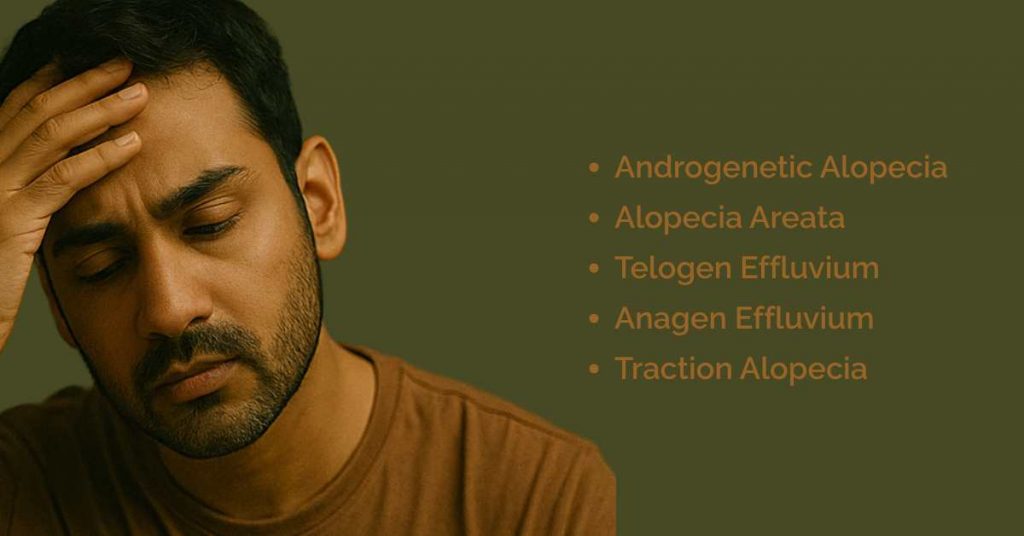
- ANDROGENETIC ALOPECIA
Male or female pattern baldness, medically known as androgenic alopecia, is the most common type of hair loss. This condition is largely hereditary, meaning it is passed down through generations. However, it affects men and women differently.
For instance, if you’re a man, hair loss typically begins at the temples and crown of the head. On the other hand, if you’re a woman, you’ll likely experience diffuse thinning across the entire scalp rather than distinct bald spots.
Although androgenic alopecia is more common with age, it can start any time after puberty. Moreover, hormonal changes also play a key role. As a result, women may notice increased thinning during or after menopause.
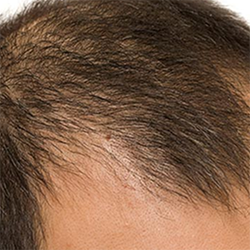
- ALOPECIA AREATA
Alopecia areata is an autoimmune disease and one of the more severe causes of hair loss. In this condition, your immune system mistakenly attacks healthy hair follicles, leading to sudden hair loss. As a result, you may notice small, round bald patches on your scalp—or in some cases, on your eyebrows.
Although the exact cause isn’t fully understood, early diagnosis is crucial. Therefore, it’s important to consult a dermatologist to explore effective treatment options and manage the condition promptly.
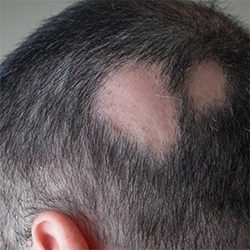
- TELOGEN EFFLUVIUM
Telogen effluvium is a type of hair loss where a larger-than-normal number of hair follicles enter the resting phase (telogen). In this condition, the loss of hair is temporary. This condition is mostly linked to your emotional and physical well being, as it occurs after a few stressful months or hormonal fluctuations. Unlike other types of hair loss, Telogen effluvium typically doesn’t lead to complete baldness and is easily treatable.
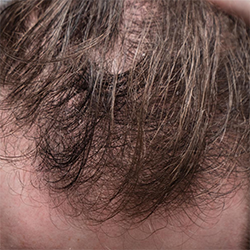
- ANAGEN EFFLUVIUM
Anagen effluvium is a rapid and severe form of hair loss that occurs during the growth phase (anagen) of the hair cycle. Unlike telogen effluvium, which causes shedding during the resting phase, anagen effluvium leads to hair loss while the hair is actively growing, thereby disrupting the normal growth cycle.
This condition is primarily triggered by external factors such as:
-Chemotherapy or Radiation
–Certain Drugs or Harmful Chemicals
–Severe Infections
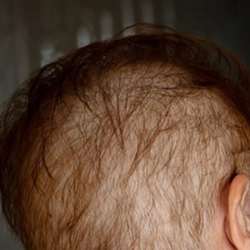
- TRACTION ALOPECIA
Traction alopecia is a condition where hair loss occurs due to intense hair pulling leading it to break away. This kind of hair loss occurs due to pulling of hair by tying it up in tight buns, ponytails or hair styles like cornrows or braids.
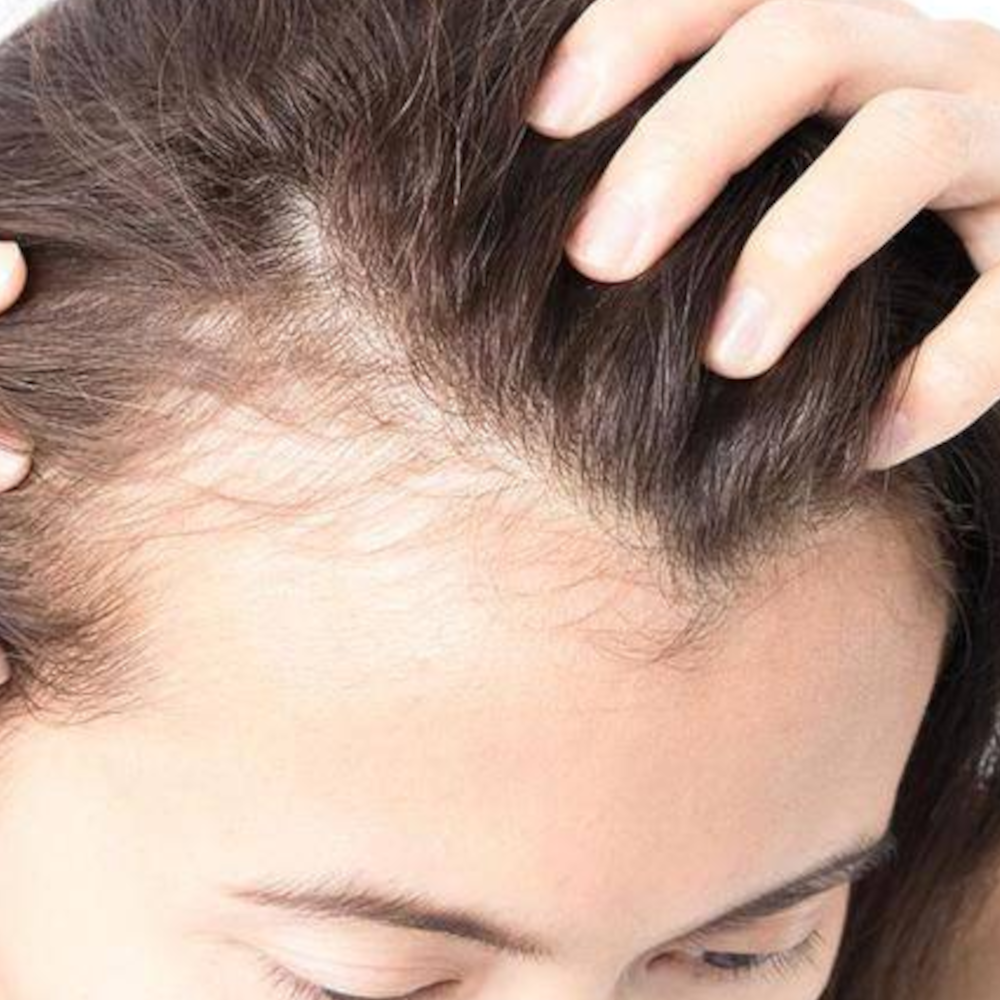
Is Hair Loss Really That Common?
Hair loss is more common than you think. Baldness affects almost 85% of males and 20%-30% in case of females in India itself. Almost 2% of the world population is affected by alopecia areata.
What Are The Causes Of Hair Loss?

The causes of hair loss are not totally identified yet, but some of the main causes of hair loss include:
- GENETICS
Genetics are one of the most important causes of hair loss. Androgenic alopecia or male or female pattern baldness is mainly driven due to genetic predisposition and sensitivity to DHT or dihydrotestosterone (a hormone which stimulates hair growth).
- HORMONAL IMBALANCE
Conditions like polycystic ovary syndrome, pregnancy, menopause, or thyroid disorders (hyperthyroidism or hypothyroidism) can disrupt the hair growth cycle. This can lead to hair thinning or shedding. Post-partum hair loss is a common example where hormonal fluctuations after childbirth cause noticeable hair fall.
- STRESS
Physical stress and emotional distress can push a large number of hair follicles into resting (telogen) phase prematurely.
- AGE
Ageing slows the process of hair growth. At a certain point, the hair follicles stop growing, leading to hair thinning or receding hair line.
- NUTRIENT DEFICIENCIES
Poor diet and lack of proper nutrients leads to hair loss. Nutrients like zinc, vitamin D, biotin, and protein are the key components of hair growth. Without these nutrients, the hair becomes brittle and breaks off easily.
- AUTO-IMMUNE DISORDERS
Auto-immune disorders like alopecia areata, where the hair follicles are mistakenly attacked by your immune system. This leads to patchy baldness in our hair.
- MEDICAL TREATMENTS
Treatments like chemotherapy or radiation can damage your hair rapidly by dividing cells. This causes sudden, widespread hair loss. Medications like antidepressants, blood thinners and beta blockers result in diffuse thinning.
- SCALP INFECTIONS
Inflammatory scalp conditions like psoriasis, seborrheic dermatitis and fungal infections like ringworm can severely damage the scalp’s environment. This leads to disrupted hair growth, weakened hair growth, or patches of hair loss.
- HAIR STYLING PRACTICES
Tight hairstyles like braids and ponytails pull out the hair from its roots. If this is continued there is irreversible damage to the scalp. Same goes for colouring hair or bleaching it.
- ENVIRONMENTAL FACTORS
Pollution, humidity, sun exposure impacts scalp health, production of natural oil production of our hair, and disrupts hair growth. All of these factors result in slow or no regeneration of hair, causing hair loss.
How To Identify The Symptoms Of Hair Loss?
Symptoms of hair loss are easily identified. The most common ones are right in front of your eyes. Those include:
- Thinning of hair or receding of hairline. These are the most common symptoms of hair loss. Usually it happens due to age. For a man, the hair starts to recede from the forehead. In the case of a woman, the hair parting area becomes wider.
- You may be noticing patchy or coin-sized bald spots on scalp, eyebrows, or beard then maybe noticing signs of alopecia areata. In this case you may also experience itchy skin before the hair loss.
- Large clumps of hair falling out when brushing, washing, or running your fingers through your hair.
- Loss of hair from the entire body due to medical treatments like chemotherapy for cancer.
- Loss of hair from the entire body due to medical treatments like chemotherapy for cancer.
- Patches of scaling on the scalp is the primary cause of ringworm. It also includes broken hair, redness, and swelling.
Hair Loss In Women: A Different Beast
You cannot completely stop the process of hair loss but you can definitely slow it down. Here are some easy ways you can prevent hair loss:
- Try to always include a clean and healthy diet that includes enough calories and proteins.
- Destress yourself regularly.
- Manage conditions and diseases that can lead up to hair loss like thyroids.
- Try to avoid hairstyles that tugs on your hair too much.
- Avoid any harmful habits like smoking or alcohol consumption.
- Brush your hair as gently as you can.
- Minimize the usage of styling products that include heat like hair straighteners and curling irons.
When To See a Medical Professional?
If you start noticing persistent hair loss or patchy baldness, it’s crucial to consult a dermatologist without delay. Such conditions require expert evaluation and personalized treatment. Fortunately, one of the best clinics in town you can trust is Wizderm Skin and Hair Clinic.
At Wizderm, advanced hair treatments are not only effective but also convenient and painless. So, as soon as you observe the symptoms of hair loss, simply book a consultation — and take the first step towards healthier hair!
FAQs
Can hair loss due to stress be reversed?
Yes, absolutely! It is very important to destress yourself every day to help reduce hair loss. You can try various destressing methods, such as aromatherapy, meditation, and more, to calm both your mind and body.
How do I know if my hair loss is genetic or due to other causes?
The best way to determine if your hair loss is hereditary is to look for signs of similar hair loss in the older generations of your family.
Are over-the-counter hair loss products effective?
Most of the time, over-the-counter products are highly effective for managing hair loss. However, in severe conditions like alopecia areata, professional dermatological intervention becomes necessary.
What diet changes can help prevent hair loss?
You don’t necessarily need to make drastic changes to your diet—unless you frequently consume junk food. Instead, focus on maintaining a healthy and clean diet to support your hair health.



